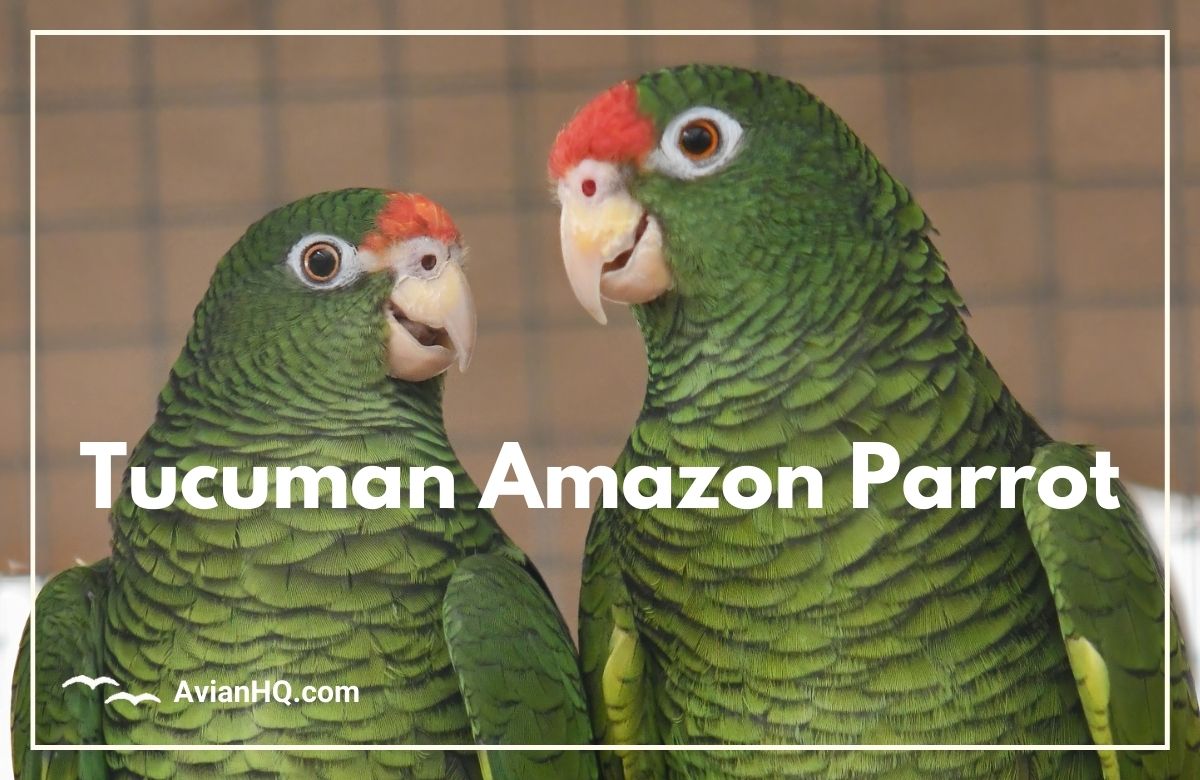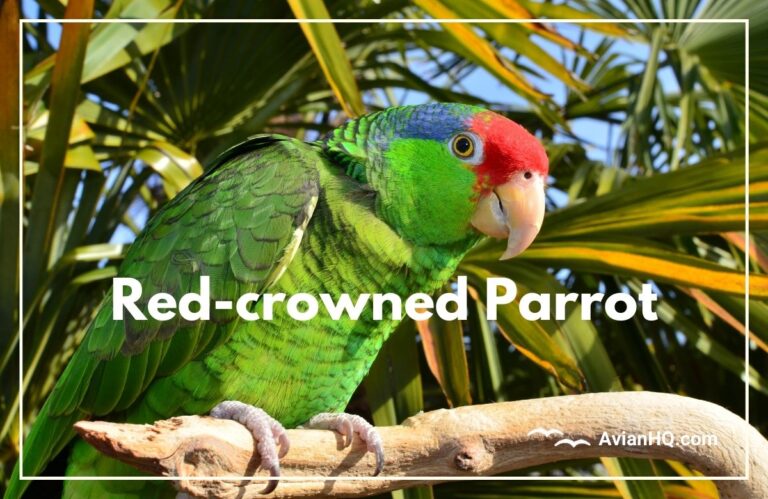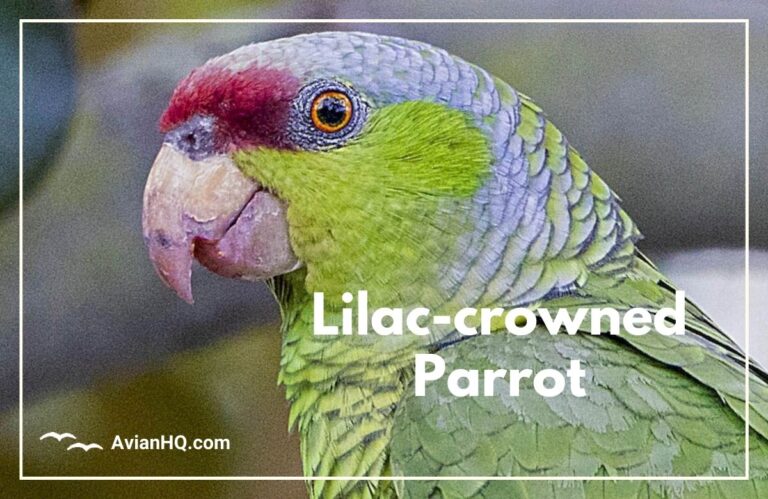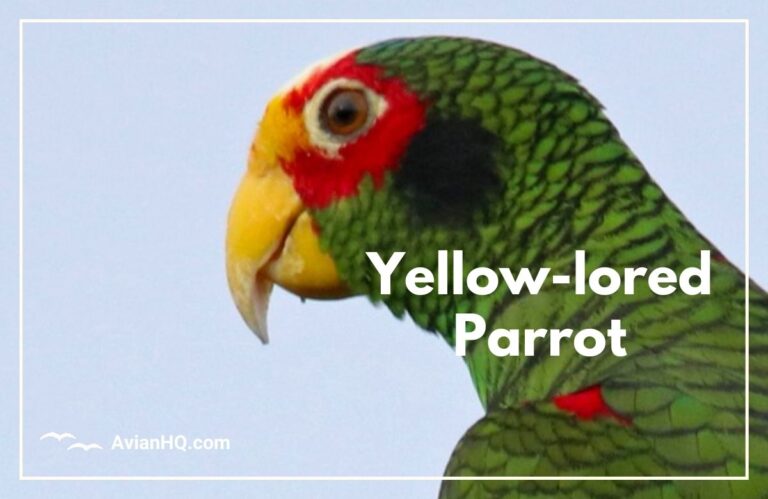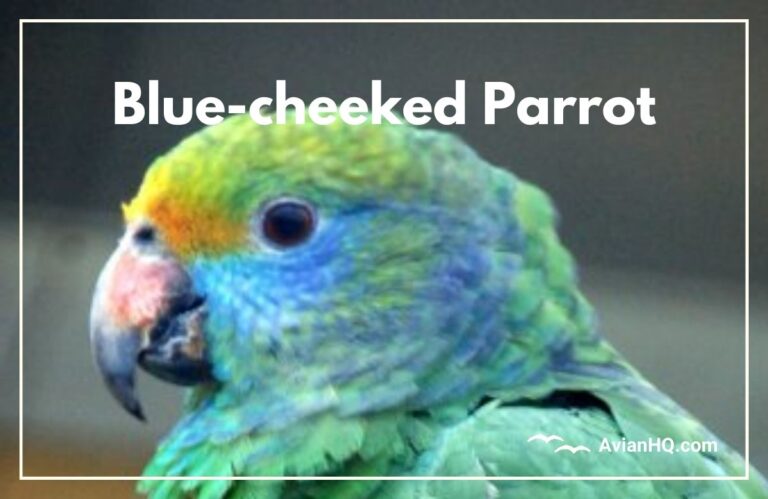Tucuman Amazon Parrot (Amazona tucumana)
The Tucumán amazon Parrot (Amazona tucumana) is a beautiful green Amazon parrot that makes its home in a small section of South America. Measuring about 12-13 inches (31-33 cm) from head to tail, this parrot is mostly bright green with a red forehead and some neat black edging on its body feathers. When you see a Tucuman Parrot flying overhead, you’ll notice bright red and blue patches on its wings too!
These parrots live in the Yungas forests on the eastern slopes of the Andes mountains in northern Argentina and southeast Bolivia. Here they nest high on mountain slopes covered in trees like alders and podocarpuses. Tucuman Parrots prefer elevations between about 5,500 and 9,000 feet (1,700 and 2,700 meters).
The IUCN Red List classifies this species as Vulnerable. Even though Tucuman Parrots can live 40-50 years, their total population is declining. There are likely less than 15,000 mature birds remaining in the wild.
In this article, you’ll learn all about the unique traits of the Tucuman Parrot: from what it eats to how it breeds, its special behaviors, current conservation efforts, and more. Understanding this species is key to protecting it for the future.
History and Taxonomy
The Tucuman Parrot was first discovered by Western science in 1875. French ornithologist Émile Deville described the species using a specimen collected in Tucumán province, Argentina. He gave it the scientific name Chrysotis tucumana, recognizing the region where it was first found.
Today the accepted name for this parrot is Amazona tucumana. The genus name Amazona refers to the Amazon parrots, while the species name tucumana connects back to the Tucuman region where the type specimen originated. No subspecies of this parrot have been defined.
Some scientists previously considered the Tucuman Parrot to be the same species as the Red-spectacled Amazon (Amazona pretrei) which lives farther north. However, multiple studies have confirmed they are distinct sister species based on differences in their appearance, vocalizations, genetics, and geographic separation.
The Tucuman Parrot is most closely related to a group of other Amazona parrots living in South America’s Gran Chaco region like the Blue-fronted Amazon and Red-lored Amazon. Evolutionary relationships within the genus continue to be studied using new genetic analysis techniques.
Physical Appearance
The Tucuman Parrot is a medium-sized parrot measuring about 12-13 inches (31-33 cm) from head to tail. Their overall body plumage is bright green. Each feather has a black edge that gives the body a neat scaly appearance.
The most noticeable markings are the bright red patch on the forehead and forecrown. Some red coloring may also extend behind the eyes. The area around the eyes is bare white skin.
When in flight, Tucuman Parrots reveal other vibrant colored patches. Their wings have red primary feathers edged in blue along with some yellow and green secondary feathers. The undertail coverts are also yellow-green.
The tail feathers are mostly green with yellowish-green tips. At the base near the body, the tail feathers are tinged with red. The upper side of the thighs has vibrant orange-yellow patches.
The bill of the Tucuman Parrot is a light pinkish-tan color. The irises of the eyes are orange or red. The legs are a greyish-pink shade.
Male and female Tucuman Parrots have identical external appearance. Juvenile birds look similar but have less red on the head, greener thighs, and darker grey or brown eyes.
Habitat and Distribution
The Tucuman Parrot is endemic to the Yungas region of South America. Its native habitat stretches across parts of Bolivia and Argentina.
In Bolivia, these parrots occur in the southern Yungas mountain forests in the departments of Chuquisaca and Tarija. Their Argentine range includes the provinces of Salta, Jujuy, Tucumán, and Catamarca.
They mainly inhabit montane cloud forests rich with tree species like alders, podocarpuses, cedars, willows, and juglans. This mountain forest habitat lies between elevations of approximately 5,250-8,500 feet (1,600-2,600 meters).
Tucuman Parrots will migrate seasonally to lower elevations down to 1,650 feet (500 meters) in the winter months of August-October. But they return to higher mountain forests to breed each spring and summer.
A few small introduced populations have become established globally thanks to escaping pets. But their total global distribution remains concentrated in the Yungas region straddling northern Argentina and southeast Bolivia. Protecting habitat across this restricted native range is vital for the species’ long-term survival.
Diet and Feeding
The Tucuman Parrot is an opportunistic and adaptable forager that enjoys a wide variety of foods. Their diverse diet includes seeds, fruits, flowers, nuts, and berries from numerous rainforest plants.
Some key natural foods sources used by these parrots are seeds and fruit from podocarpus and alder trees. They also forage on seeds from acacia, juglans, cedar, and willow trees as well as fruit from myrcianthes and bleeding heart trees.
Tucuman Parrots have been observed traveling up to 6 miles (10 km) daily during the breeding season to take advantage of concentrated food sources. One important winter food is the nut crop from native oak trees.
These parrots use their strong curved bill to crack open hard nuts and seeds. They manipulate fruits and flowers with their dexterous tongue and feet to extract nectar and juice. Feeding normally takes place in small flocks foraging together high in the rainforest canopy.
In captivity, the Tucuman Parrot’s diet aims to mimic their diverse natural diet. Recommended foods include a quality parrot seed mix along with ample vegetables, fruits, sprouted beans, nut and seed treats, greens, and flower parts.
Breeding and Reproduction
The breeding season for Tucuman Parrots lasts from November through January each year. To prepare for nesting, pairs will seek out a suitable tree cavity high up near the tops of tall rainforest trees.
Favored nest sites are often old woodpecker holes excavated previously in trees like podocarpuses, alders, oaks or willows. The inner dimensions of the cavity must be at least 12 x 12 x 24 inches (30 x 30 x 60 cm).
The typical clutch size is 3-4 white eggs which are incubated by the female for 26-30 days while the male brings food. After hatching, both parents share feeding duties as the chicks grow.
The young parrots fledge at around 50-58 days old. But they continue to be fed and taught to forage by their parents for up to 10 more weeks after fledging while they build flight strength and independence.
Tucuman Parrots are thought to reach sexual maturity between 3-5 years old. Their average lifespan in the wild is estimated up to 50 years. So mature pairs may return to the same tree cavities for many seasons to raise new chicks together.
Behavior and Ecology
The Tucuman Parrot is a highly social species that spends most of the year roaming and feeding in flocks. Their flock sizes can vary widely from a few birds up to aggregations of 200 individuals.
At special communial roost sites, even larger flocks exceeding 1,000 Tucuman Parrots may gather to sleep overnight before dispersing again at dawn. These roosts are very important social hubs and information centers supporting the local population.
Tucuman Parrots are noisy, active foragers that cover several miles of mountain forest habitat each day searching for ripening fruits and seed sources. Their loud contact calls ring through the canopy signalling the discovery of plentiful food bonanzas.
Flocks exhibit complex hierarchies and tightly bonded breeding pairs will defend nesting territories from competitors and predators. Some key natural threats include large raptors, arboreal snakes, and toucans competing for similar tree cavity nest sites.
Outside of nesting season, Tucuman Parrots tolerate other avian species while feeding and roosting communally. Mixed flocks containing macaws, toucans, parakeets and tanagers are sometimes observed overaging fruit trees together. But competition for limited nest sites remains strong.
Conservation Status
The current conservation status of the Tucuman Parrot is considered Vulnerable by the IUCN Red List criteria. While no precise population surveys exist, their total global population is unlikely to exceed 15,000 mature individuals and is suspected to be decreasing.
Major threats fueling the decline of Tucuman Parrots include ongoing habitat loss across their native Yungas forest range and trapping for the illegal pet trade. Their limited and fragmented range makes the species very vulnerable.
In Argentina, over 90% of suitable habitat has already been lost and degraded. Remaining habitat exists in small isolated patches that may not support successful breeding. Nest poaching and live capture for profit also continue despite trade bans.
Bolivia still harbors significant intact areas of Yungas forest which will be critical for the long-term survival of sustainable Tucuman Parrot populations. However, logging, burning, grazing, and development pressures remain substantial threats here as well.
Concerted conservation action is needed to protect remaining habitat corridors and roost sites while combating any illegal poaching activities. Improved farming practices, forest restoration projects, and expanded national parks will also benefit the Tucuman Parrot’s future. Without support, this unique parrot may soon disappear from South American skies.
Conclusion
The beautiful Tucuman Parrot, with its vibrant green and red plumage, is one of South America’s unique Yungas forest inhabitants. Yet this species risks disappearing if urgent conservation action is not taken.
From an estimated historic population of over 35,000 birds, habitat destruction and poaching pressure have drastically reduced Tucuman Parrot numbers to less than 15,000 mature adults and still falling. Time is running out to reverse this dangerous decline.
Protecting the Tucuman Parrot will require coordinated efforts on several conservation fronts across the parrot’s Argentina-Bolivia range. Further habitat loss must be prevented while also restoring degraded corridors. Anti-poaching campaigns, enforcement of trade bans, and public awareness can target the persistent threat of nest robberies and live capture.
Bolivia in particular still holds essential intact Yungas forest tracts and sizeable Tucuman Parrot populations that can serve as the strongholds for future recovery. Regional cooperation and funding support for comprehensive conservation strategies will give the species its best chances.
The Tucuman Parrot has flown over the South American Andes for thousands of years. With rapid action today by governments, scientists, nonprofits, and local communities – this vivid ambassador of the Yungas may continue coloring Argentina’s and Bolivia’s skies for thousands more.

